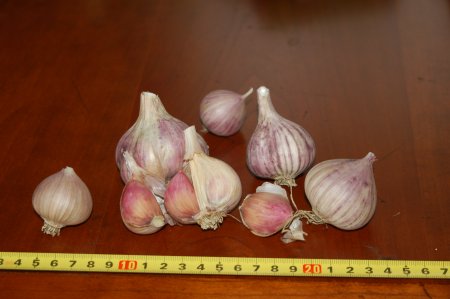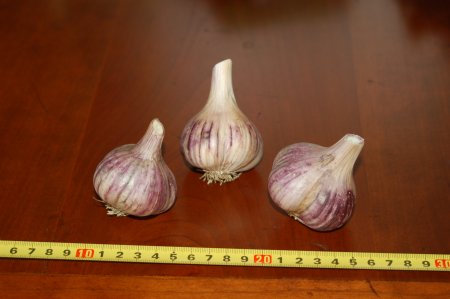If I were still in school, this would probably be my project report, but since I’m not we’ll just call this some notes. I learned a lot of things growing garlic the last few years, both in the garden and talking with others about it.
Choosing the Varieties
This year I grew about 70 different kinds of garlic. Dutch customs opened up one shipment of garlic that was shipped in a plastic blister pack, and six of the varieties got mixed together. This was a ‘rare and exotic heirloom sampler’. Over the phone I tried to sort out with the supplier which garlic was which, but some were too similar. Since a couple of the varieties turned out to be duplicated in other orders, I thought I would be able to compare them, but since they were grown in different climates this didn’t work. I thought I would be able to compare them after a year of growing them in my garden, but the situation is still not clear. This is why I say ‘about’ 70 kinds of garlic.
For anyone who has the space and ability to grow this many different kinds, I would recommend it. It was great to compare the different types, all with different characteristics. If you aren’t able to grow so many, there are some important things to consider when choosing the varieties to grow.
First, there are 10 different garlic types. I would suggest trying at least one of each type. Some are more suited to warmer or cooler climates, or higher or lower latitudes, but almost all of them will survive everywhere. They all have different properties, and it’s worth getting to know them. In the end, you may settle on 10 garlics to keep growing, one of each type.
The Rocamboles and Porcelains usually have the best tastes, so be sure to grow at least one of these.
Think about storage properties, and try to grow at least one kind of garlic that will last a long time. Around February or March it can be hard to find garlic that’s nice to eat, even in the stores. By April or May you can eat some of the garlic greens from your garden, or dig up a few immature bulbs as ‘spring garlic’. The silverskins are the longest lasting, and the artichokes and asiatic turbans usually the shortest.
Get your garlic locally, or from a similar climate, altitude and latitude. It takes a few years of successive planting for garlic to become acclimated to your garden, and it will go a lot faster if the planting stock comes from some place similar.
Get recommendations from other people who have grown garlic. The best place to start is with a variety liked by someone you trust, especially if they live in a climate similar to yours. Besides, maybe you can get some free planting stock from them!
Evaluating Different Varieties
If there is anything I’ve discovered in growing garlic is it’s very hard to subjectively evaluate anything. The same garlic, grown in different climates or even in the same garden from one year to the next, can vary tremendously. The appearance and taste can really be completely different.
I’ve noticed there are not many pictures of garlic varieties on the Internet, which is one of the reasons I tried to post several of them, but I think the reason is mostly because the appearance of the different varieties changes so much. Any store publishing a picture is just going to be criticized by customers who grow something different looking in their own garden.
When it comes to tasting garlic, there is one really overwhelming aspect to it. It tastes like garlic! To try to taste 2 or 3 different garlics at the same time, and compare and contrast them, is almost impossible to do. To appreciate a garlic you have to spend some time cooking with it, try it raw and cooked, as well as cooked in different ways. Since it’s normal I would eat about 10 bulbs of garlic in a year, when I grow 70 different varieties, it’s just impossible to evaluate them all. Not to mention, even if I did manage to evaluate them all, as soon as you grew the garlic in your own garden or even the following year in my own garden, my evaluations may not mean anything anymore.
In addition to changing from one location or year to the next, different people taste garlic differently. When tasted by 2 different people, the same bulb of garlic can seem hot or mild, weak or strong. Steph and I often sit down to a meal, both of us complaining, me saying I can’t taste the garlic and her saying the food is ruined because there’s too much.
I can tell you with some certainty that there are some varieties of garlic I like, and others I don’t like very much. I can also tell you which grow the best in my garden. It’s really hard to say much more than that.
The other thing I can say with absolute certainty is after growing and eating my own garlic from my own garden, supermarket garlic tastes like garbage!
Cloves, Scapes and Bulbils
Conventional wisdom says you should always remove the scape after it appears because it you can eat it, it tastes good and removing it promotes good bulb growth. In addition, growing garlic from bulbils is too much trouble because it takes at least 2 years to get full sized bulbs.
I’ve really discovered this year this in not always true!
If you view your vegetable garden in the traditional, non heirloom and non seed saving way, then planting cloves of purchased planting stock fits this model. It is probably the best way to get instant satisfaction, and a good harvest the first year.
If you are a slightly advanced gardener or more oriented towards heirloom gardening, bulbils can be very useful. Bulbils are much easier to package and ship than garlic bulbs. Bulbils are also much more likely to be free from diseases than bulbs and cloves. Garlic grown from bulbils normally takes at least 2 years of growing and replanting to reach full size, but it will acclimate to your garden much faster and in the long run is an advantage.
The increase in bulb size is not that much when you remove the scape, and is probably much more important to the farmer who is measuring his or her harvest in tons. The home gardener won’t notice much difference. You also get an increase in size when your garlic is covered with mulch for the winter, and this is probably more important.
Bulbils are also very useful when you are trying to grow out your garlic into as many bulbs possible in the shortest time possible. By planting both cloves and bulbs, you will end up with more plants in the long run.
Viruses are not normally carried in the bulbils, so if your garlic is infected and you want to remove the virus, you can normally do this by growing fresh planting stock from the bulbils.
Viruses
Until now, I haven’t paid very much attention to this, but I realize this is an important issue. There are a handful of viruses, and there are pictures of infected plants on the Internet. As I understand these are transmitted mostly by physical contact between the leaves of the plants, especially when the leaves are damaged thus allowing the virus in or out. Allowing more space between plants can reduce the spread.
Growing garlic from bulbils will often get rid of viruses, but if the garlic doesn’t develop bulbils you have to find another way. I’m not sure what you can do in this case.
If you are just growing garlic in one go from purchased planting stock, viruses are not really an issue. If you are saving your own garlic from one year to the next, you will probably want to avoid viruses as much as possible, and know how to identify them.
Crop Rotation
I can’t emphasize the importance of this enough. Many garlic diseases are soil bound, and once established in the ground are very hard to get rid of. Once a lot of garlic was grown in California, but this isn’t true anymore in part because the ground is too full of diseases from improper crop rotation. Never plant garlic in the same ground more than once in 4 years, and a longer time is better if possible. I have spoken to some garlic growers in the US who never use the same ground twice for garlic. This is great to do if you have enough space.



